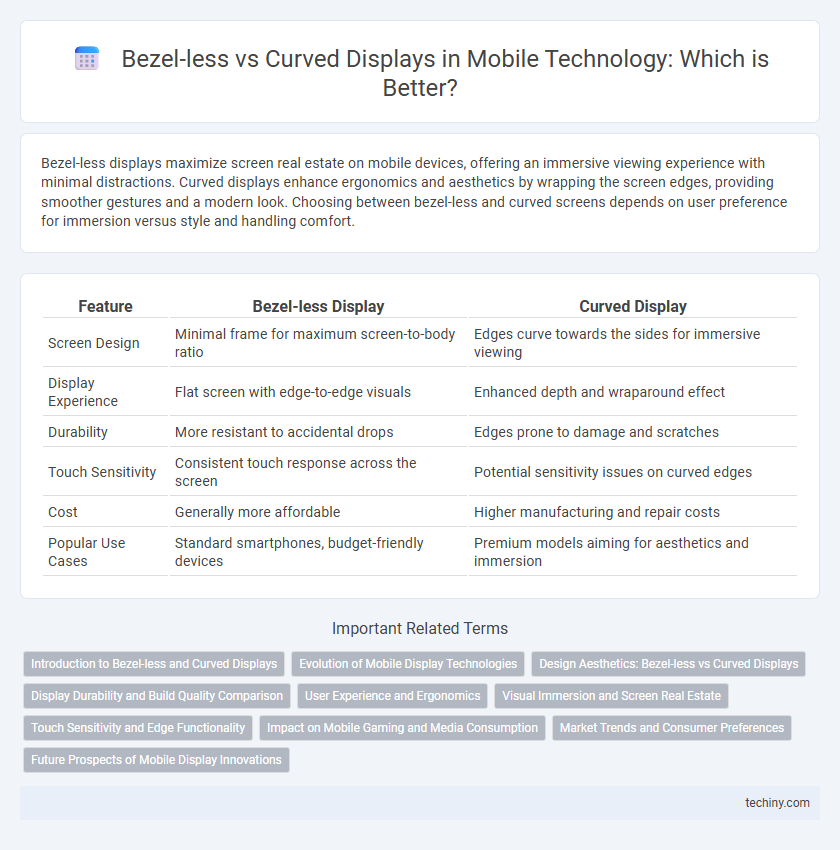Bezel-less displays maximize screen real estate on mobile devices, offering an immersive viewing experience with minimal distractions. Curved displays enhance ergonomics and aesthetics by wrapping the screen edges, providing smoother gestures and a modern look. Choosing between bezel-less and curved screens depends on user preference for immersion versus style and handling comfort.
Table of Comparison
| Feature | Bezel-less Display | Curved Display |
|---|---|---|
| Screen Design | Minimal frame for maximum screen-to-body ratio | Edges curve towards the sides for immersive viewing |
| Display Experience | Flat screen with edge-to-edge visuals | Enhanced depth and wraparound effect |
| Durability | More resistant to accidental drops | Edges prone to damage and scratches |
| Touch Sensitivity | Consistent touch response across the screen | Potential sensitivity issues on curved edges |
| Cost | Generally more affordable | Higher manufacturing and repair costs |
| Popular Use Cases | Standard smartphones, budget-friendly devices | Premium models aiming for aesthetics and immersion |
Introduction to Bezel-less and Curved Displays
Bezel-less displays feature minimal borders around the screen, maximizing the visible area and delivering an immersive viewing experience critical for modern smartphones and tablets. Curved displays extend this concept by incorporating edges that curve around the device, enhancing ergonomics and visual appeal while reducing glare and reflections. Both technologies leverage OLED and AMOLED panels to achieve high contrast ratios, vibrant colors, and improved screen durability in mobile devices.
Evolution of Mobile Display Technologies
Bezel-less and curved displays represent significant milestones in the evolution of mobile display technologies, enhancing screen-to-body ratios for immersive user experiences. Bezel-less designs minimize frame borders, allowing larger screens without increasing device size, while curved displays offer ergonomic benefits and improved aesthetics with edge-wrapped visuals. Advances in OLED and flexible AMOLED panels have driven these innovations, enabling thinner bezels and smooth curvature, shaping the future of smartphone interfaces.
Design Aesthetics: Bezel-less vs Curved Displays
Bezel-less displays offer an immersive viewing experience by maximizing screen-to-body ratio, creating a sleek and modern look favored in minimalist smartphone designs. Curved displays enhance ergonomic appeal and depth perception, providing a futuristic aesthetic that emphasizes fluidity and elegance. Both designs prioritize visual immersion, with bezel-less focusing on maximizing display area and curved displays adding a distinct dimensionality to device contours.
Display Durability and Build Quality Comparison
Bezel-less displays often feature reinforced glass and metal frames that enhance overall durability, minimizing edge damage due to their flat design. Curved displays, while visually immersive, are more susceptible to impact damage along the edges and require advanced manufacturing techniques to maintain build quality. Research in mobile technology shows that devices with bezel-less screens typically exhibit higher resistance to drops and scratches compared to curved screen phones, influencing consumer preferences for longevity.
User Experience and Ergonomics
Bezel-less displays offer an immersive viewing experience by maximizing screen real estate, enhancing content visibility without distraction. Curved displays improve ergonomics by reducing glare and minimizing eye strain through a wider field of view that naturally aligns with the shape of the human eye. Both technologies contribute to user comfort, but bezel-less designs prioritize seamless interaction while curved screens emphasize visual comfort and grip stability.
Visual Immersion and Screen Real Estate
Bezel-less displays maximize screen real estate by minimizing borders, creating a more expansive viewing experience ideal for multimedia consumption and gaming. Curved displays enhance visual immersion through subtle wrapping, reducing glare and reflections while expanding the perceived field of view. Both technologies optimize user interaction by blending design aesthetics with functional screen space, but curved panels provide a distinctive depth effect that bezel-less flat screens cannot achieve.
Touch Sensitivity and Edge Functionality
Bezel-less displays maximize screen real estate but can sometimes reduce touch sensitivity near the edges due to minimal frame support, leading to accidental touches and lower edge responsiveness. Curved displays enhance edge functionality, enabling intuitive gestures and shortcuts while maintaining consistent touch sensitivity around the screen perimeter. Manufacturers balance these design elements to optimize user interaction, ensuring precise touch response and functional edge controls in mobile devices.
Impact on Mobile Gaming and Media Consumption
Bezel-less displays maximize screen real estate, enhancing immersion in mobile gaming and media consumption by providing uninterrupted visuals and a larger viewing area. Curved displays improve depth perception and offer a more cinematic experience, reducing glare and reflections on the edges for better visual comfort during extended gaming sessions. Both technologies contribute to user engagement, but bezel-less designs prioritize expansive content visibility while curved screens emphasize ergonomic viewing angles and aesthetics.
Market Trends and Consumer Preferences
Bezel-less displays dominate the smartphone market due to consumers' preference for immersive viewing experiences and larger screen-to-body ratios, enhancing multimedia consumption and gaming. Curved displays, though less prevalent, appeal to premium segments by offering aesthetic appeal and ergonomic comfort, driving innovation in flagship devices. Market trends indicate rising demand for bezel-less designs, with manufacturers investing in advanced screen technologies to maximize display real estate while balancing durability and cost.
Future Prospects of Mobile Display Innovations
Bezel-less and curved mobile displays represent significant advancements in mobile technology, with future prospects leaning towards seamless integration of flexible OLED and micro-LED panels to enhance user experience. Emerging innovations emphasize durability, energy efficiency, and immersive visuals by minimizing physical screen borders and enabling edge-to-edge content display. Market trends suggest increased adoption of foldable and rollable displays, driven by consumer demand for versatile, pocket-sized devices with maximum screen real estate.
Bezel-less vs Curved display Infographic

 techiny.com
techiny.com